Bulbs
Flower Basics
Flower Beds & Specialty Gardens
Flower Garden
Garden Furniture
Garden Gnomes
Garden Seeds
Garden Sheds
Garden Statues
Garden Tools & Supplies
Gardening Basics
Green & Organic
Groundcovers & Vines
Growing Annuals
Growing Basil
Growing Beans
Growing Berries
Growing Blueberries
Growing Cactus
Growing Corn
Growing Cotton
Growing Edibles
Growing Flowers
Growing Garlic
Growing Grapes
Growing Grass
Growing Herbs
Growing Jasmine
Growing Mint
Growing Mushrooms
Orchids
Growing Peanuts
Growing Perennials
Growing Plants
Growing Rosemary
Growing Roses
Growing Strawberries
Growing Sunflowers
Growing Thyme
Growing Tomatoes
Growing Tulips
Growing Vegetables
Herb Basics
Herb Garden
Indoor Growing
Landscaping Basics
Landscaping Patios
Landscaping Plants
Landscaping Shrubs
Landscaping Trees
Landscaping Walks & Pathways
Lawn Basics
Lawn Maintenance
Lawn Mowers
Lawn Ornaments
Lawn Planting
Lawn Tools
Outdoor Growing
Overall Landscape Planning
Pests, Weeds & Problems
Plant Basics
Rock Garden
Rose Garden
Shrubs
Soil
Specialty Gardens
Trees
Vegetable Garden
Yard Maintenance
Cedar Tree Fungus
Cedar Tree Fungus. While fungus attacks take many forms, the two main diseases that fungus cause on cedar trees are cedar-hawthorn rust and cedar-apple rust. It's not difficult to tell these diseases apart.

While fungus attacks take many forms, the two main diseases that fungus cause on cedar trees are cedar-hawthorn rust and cedar-apple rust. It's not difficult to tell these diseases apart.
Cedar-Hawthorn Rust
The fungus Gymnosporangium globosum causes cedar-hawthorn rust on eastern red cedar and southern red cedar trees. Trees affected with cedar-hawthorn rust will produce galls for more than one season, while trees with cedar-apple rust will not.
Cedar-Apple Rust
Cedar-apple rust occurs in greater volume in states where apples are a major crop. This fungal disease only occurs where red cedar trees and apple trees grow in proximity.
Signs of Cedar-Hawthorn Rust
Affected trees develop reddish-brown growths on the leaves that eventually swell and produce spiky horns in wet weather. These galls do not cause foliage to die.
Signs of Cedar-Apple Rust
Round galls develop on cedar trees affected with cedar-apple rust. The galls develop orange protrusions in the spring but do not damage the cedar trees greatly.
Prevention/Solution
Plant varieties of cedar tree that are resistant to these two rust diseases.
Control
You can spray cedar trees with fungicide to cure a fungal infection. Check with your local county extension office to find approved fungicides before you spray.